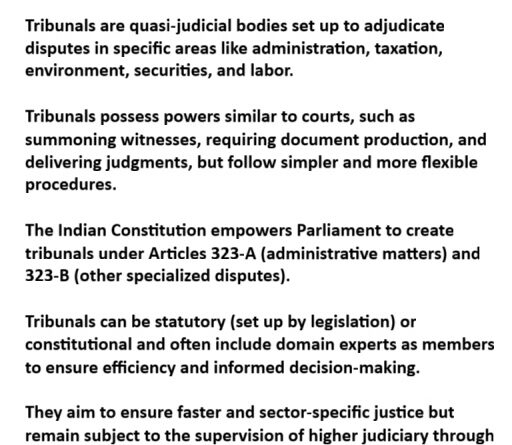Supreme Court Strikes Down Tribunal Reforms Act
Contents
Supreme Court Strikes Down Tribunal Reforms Act, 2021: A Constitutional Stand
What Are Tribunals?
Tribunals are quasi-judicial bodies established to adjudicate specialized disputes more expeditiously and affordably than regular courts. They combine judicial and technical expertise to settle matters across domains such as taxation (Income Tax Appellate Tribunal), environment (National Green Tribunal), telecom, electricity, and labor disputes.
Constitutional Basis: Articles 323A and 323B of the Constitution empower Parliament and state legislatures to establish tribunals. Article 323A governs tribunals for matters related to recruitment and service conditions of public employees, while Article 323B covers tribunals for taxation, land reforms, foreign exchange, industrial disputes, and other matters. Tribunals are hierarchical in structure, with appeal mechanisms built in, and comprise both judicial members and expert technical members.
What Did the Government Want?
The Tribunal Reforms Act, 2021 aimed to streamline the tribunal system through three key changes:
Abolition of Nine Tribunals: Dissolving appellate bodies like the Film Certification Appellate Tribunal and Airports Appellate Tribunal, transferring their functions to High Courts to reduce administrative burden and costs.
Tenure Reduction: Shortening tribunal members’ tenure from five years to four years with eligibility for reappointment, and setting a minimum age of 50 years for appointment.
Centralized Control: Allowing the central government greater authority over appointment procedures and service conditions through Search-cum-Selection Committees controlled by government secretaries.
The government argued these changes would improve efficiency and reduce unnecessary layers of litigation.
Why Did the Supreme Court Strike It Down Tribunal Reforms Act 2021 ?
On November 19, 2025, Chief Justice B.R. Gavai and Justice K. Vinod Chandran delivered a crucial judgment, striking down the Act’s provisions on the grounds of unconstitutionality.
Key Reasons:
1. Violation of Judicial Independence: The Court found that the four-year tenure and age restrictions undermined tribunal independence by making members vulnerable to executive pressure and reappointment threats.
2. Legislative Override: The most damning finding was that the 2021 Act was a “sly revival” of provisions the Court had previously struck down in 2020. The government merely repackaged identical provisions with minor tweaks rather than curing the constitutional defects. This violated the doctrine of constitutional supremacy—Parliament cannot bypass binding judicial directions.
3. Separation of Powers: By allowing government dominance over appointment committees and tenure, the Act violated the foundational principle that tribunals must remain independent adjudicatory bodies, especially since the Centre is often the biggest litigant.
4. Disrespect for Judicial Precedent: The Court censured the government for “repeatedly choosing not to accept the directions of this Court,” stating such defiance was “unfortunate and inconsistent” with the Constitution’s spirit as envisioned by Dr. Ambedkar.
The Court’s Directive
The Supreme Court directed the Union government to establish a National Tribunal Commission within four months to ensure transparency, independence, and uniformity in tribunal appointments and administration across the country. This commission will serve as the structural safeguard the Court deemed essential for protecting tribunal independence.
Note: The judgment reinforces that structural principles like separation of powers and judicial independence are not mere suggestions—they are binding constitutional mandates that Parliament cannot circumvent through legislative manipulation.
What Are Tribunals?
Tribunals are quasi-judicial bodies set up to adjudicate disputes in specific areas like administration, taxation, environment, securities, and labor.
They function as an alternative to traditional courts and help reduce the judiciary’s caseload by providing speedy, specialized, and cost-effective dispute resolution.
Tribunals possess powers similar to courts, such as summoning witnesses, requiring document production, and delivering judgments, but follow simpler and more flexible procedures.
The Indian Constitution empowers Parliament to create tribunals under Articles 323-A (administrative matters) and 323-B (other specialized disputes).
Tribunals can be statutory (set up by legislation) or constitutional and often include domain experts as members to ensure efficiency and informed decision-making.
They aim to ensure faster and sector-specific justice but remain subject to the supervision of higher judiciary through appeals and review
Discover more from Simplified UPSC
Subscribe to get the latest posts sent to your email.






